Converse Skateboarding: Culture, Gear, and Techniques
Intro
Skateboarding isn't just a pastime; it's a way of life for many enthusiasts, blending artistry, sport, and culture. Converse, a brand synonymous with the roots of skateboarding, stands at the forefront of this vibrant scene. Their shoes embody the spirit of the sport while connecting countless skaters through styles that withstand the test of tricks and time.
Diving into the nuances of Converse skateboarding reveals a tapestry woven with community, respect, and innovation. As the skateboarding world evolves through techniques and gear, Converse adapts, yet holds onto its significance in the culture. Whether you're aiming to catch air at a local skate park or simply cruise the streets, understanding the depth of Converse's contribution is key to truly embracing this exhilarating lifestyle.
In this article, various aspects of Converse skateboarding will be explored, from techniques and essential gear to insights on safety and community dynamics. Come along as we dissect what it means to strap on a pair of Converse shoes and experience the thrilling world of skateboarding.
Techniques and Tips
Skill Development
Developing skateboarding skills requires dedication and practice, much like learning any other art form. Beginners should start by mastering the foundational techniques. Balance is paramount; this is often achieved through constant movement. Finding your stance—whether goofy or regular—sets the stage for future growth. Solo practice sessions at home, perhaps on a smooth surface or in the driveway, can help hone these basic moves without the pressure of onlookers.
As you improve, consider adding the ollie to your repertoire. This jump is iconic in skateboarding, allowing skaters to clear obstacles and initiate tricks. Breakdown of the ollie includes crouching down, popping the tail of the board down with your back foot, and sliding your front foot up towards the nose in one fluid motion.
Practical Techniques
The world of skateboarding is vast, filled with countless tricks varying in difficulty. Once you've got your basic moves down, it's time to explore some practical techniques:
- Kickflip: A fundamental trick that involves using the toes to kick the board sideways while jumping.
- Grind: This involves sliding along a rail or ledge, a great way to show finesse.
- Heelflip: Similar to a kickflip, it requires the opposite foot movement, adding variety to your tricks.
Common Mistakes to Avoid
Every skater, beginner or veteran, encounters pitfalls along the way. Nightmares like falling on landing or losing balance can deter practice. Common mistakes include:
- Rushing the Learning Process: Mastery takes time, so move at your own pace.
- Neglecting Safety Gear: Even the best skaters fall; wear your helmet and pads.
- Improper Foot Placement: This can lead to unwanted speed wobbles or losing control.
"The journey of skateboarding is not just about mastering tricks but understanding the culture that fuels the passion behind them."
Gear and Equipment
Essential Gear for Beginners
Getting the right gear can make a world of difference, especially for newcomers. When starting, consider these essentials:
- Skateboard: Choose a deck that feels right for your size and stance.
- Trucks: These connect the wheels, affecting how the board steers.
- Wheels: Softer wheels are better for street skating; harder wheels are ideal for tricks.
- Converse Footwear: Known for durability and grip, Converse shoes designed for skateboarding provide comfort and functionality.
Latest Innovations and Trends
Skateboarding gear is perpetually evolving. Converse has been innovative in bringing advanced materials that increase durability while maintaining style. Shoes like the Converse CONS One Star Pro feature enhanced cusions and a board feel, providing optimal support during rigorous skate sessions.
Reviews and Comparisons
Many skaters enjoy sharing their experiences with different gear online. Sites like Reddit showcase threads discussing gear recommendations and product reviews, providing valuable insights. Comparing styles and functionalities can guide new skaters in choosing their equipment wisely.
Safety Measures
Essential Safety Gear
Safety should never take a backseat in skateboarding. The basic safety gear includes:
- Helmet: Always wear one, regardless of your ability. It's a lifesaver.
- Wrist Guards: Protecting delicate bones is crucial; wrist guards are a must.
- Knee & Elbow Pads: They absorb impacts, allowing for a safer experience.
Best Practices for Safe Participation
Learning and enjoying skateboarding safely requires vigilance. Here are some tips to consider:
- Know Your Limits: Practice within your capabilities before diving into complex tricks.
- Spot the Terrain: Know the area you'll be skating. Avoid cracks, holes, and slippery sections.
- Practice Regularly: The more you skate, the better you'll understand your surroundings and ride safely.
Injury Prevention and Management
Skateboarding comes with risks, but many injuries can be avoided. Stretching before and after sessions can prevent pulls and strains. It's also wise to take breaks to avoid fatigue, which can lead to accidents. Should an injury occur, ice the affected area immediately and seek medical advice if the pain persists.
Spotlights on Extreme Sports
Featured Sport of the Month
Each month, a unique discipline within extreme sports is highlighted to inspire and educate enthusiasts. This month features Freestyle BMX, showcasing a seamless blend of style and skill akin to skateboarding, featuring professional riders who take their craft to new heights.
Profiles of Prominent Athletes
The world of skateboarding is rich with narratives from both legendary figures and budding talent. Converse has worked with many notable skaters, such as Louie Lopez, who have inspired countless others with their skill and dedication. By studying their journeys, one can glean crucial insights into both technique and the culture surrounding skateboarding.
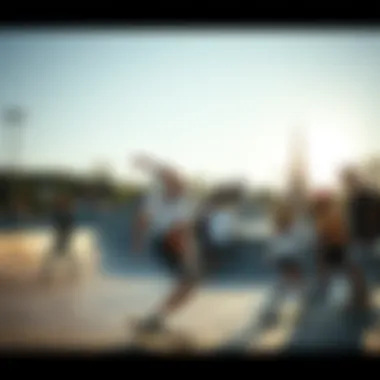
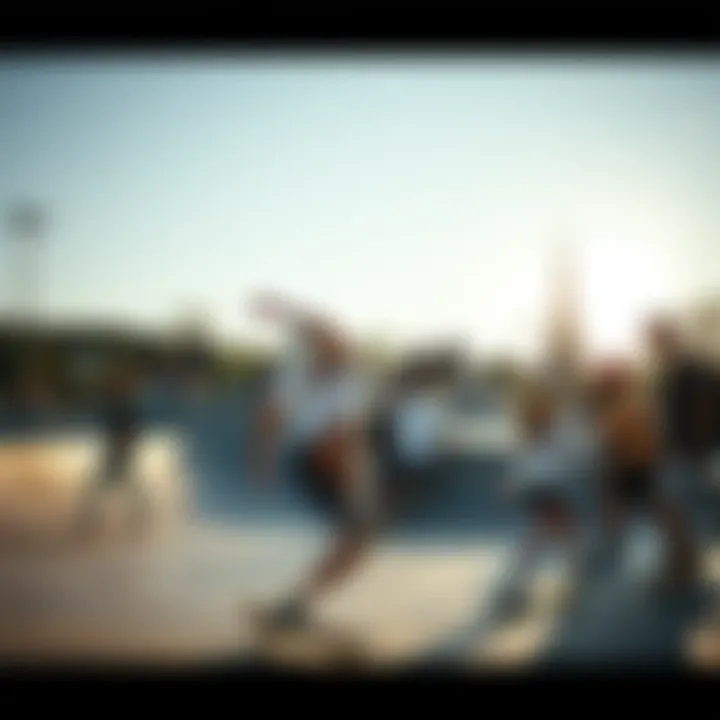
For further resources, consider checking out skateboarding community forums on Reddit or skateboarding news sites such as Skate News.
Embrace the adventure, explore the thrill, and gear up for a ride that goes beyond just standing on a board. With Converse by your side, this journey becomes not just a sport but a culture.
Historical Perspective on Skateboarding
The journey of skateboarding is not merely a tale of tricks and flips; it's a narrative woven with the threads of culture, rebellion, and innovation. Understanding this historical context is crucial, as it sheds light on how skateboarding has evolved into a global phenomenon. Recognizing the roots of the sport allows enthusiasts to appreciate the values, struggles, and milestones that shaped its current landscape.
In its infancy, skateboarding emerged in the 1950s in California, initially as a pastime for surfers looking to ride the pavement when the surf was poor. This grassroots connection to surfing ignited a passion that transcended mere recreational activity; it became a cultural expression. The very first skateboards were makeshift contraptions, often assembled from old roller skate wheels and wooden planks. The spirit of do-it-yourself ingenuity marked the early days, setting the stage for the creativity that would define skate culture.
The influence of skateboarding gradually caught the public eye during the 1970s with the advent of the first skate parks and the introduction of polyurethane wheels. This decade was pivotal, marking the transition from a hobby to an established sport. Riders began to perform tricks, turning skateboarding into an exhilarating spectacle. By the 1980s, skateboarding had entered the mainstream, spurred by iconic figures and bold designs. The rise of skateboarding magazines cultivated a community, connecting skaters and elevating skate culture.
The relationship between skateboarding and music grew, particularly with punk rock in the late 70s and early 80s, helping to crystallize skateboarding as a lifestyle rather than just a sport. This cultural intertwining fostered a sense of identity among skaters, further cementing the importance of community in the world of skateboarding.
Importantly, brands like Converse emerged, intertwining themselves with the culture by providing specialized footwear that appealed to skaters. This relationship has helped to authenticate skateboarding, presenting it not only as a sport but also as a vibrant subculture. Converse, with its storied history and connection to music, art, and fashion, became synonymous with skateboarding, establishing a loyal following that persists today.
The historical perspective on skateboarding illustrates that it is more than just riding a board. It encompasses passion, community, and an ever-evolving culture that encourages creativity and expression. Exploring this rich history helps today’s riders connect with previous generations, fostering a deeper appreciation for the culture that surrounds the sport.
The Early Days of Skateboarding
Skateboarding's early days are characterized by experimentation and a unique blend of influences. As the 1960s rolled in, young surfers sought to mimic the sensation of riding waves on solid ground. Initially, they converted their surfboards into skateboards, leading to an exciting new hobby that quickly gained traction. Teens would gather in driveways and on the streets, honing their skills while sharing laughs and camaraderie.
During this time, skateboards were rudimentary. Most were simple, wooden boards with metal wheels attached, often sourced from roller skates. Riders began developing tricks like the kickturn and ollie, experimenting with the capabilities of their boards.
In the following decade, skateboarding began to formalize. The establishment of the first skate parks in California in the 1970s provided dedicated spaces where riders could practice and push their limits. These parks were crucial in shaping the sport’s techniques and bringing skaters together, fostering a community spirit among those who shared a passion for shredding.
As the designs of skateboards improved—thanks to innovations such as wider wheels—so did the tricks. Riders began to push their boundaries, performing aerial tricks and riding half-pipes with impressive skill. This evolution marked a turning point in skateboarding, showcasing the sport's athleticism and artistry.
Converse's Role in Skate Culture
Converse has played an influential role in the narrative of skate culture from the very start. The brand's iconic Chuck Taylor sneakers were not originally designed with skateboarders in mind, but they resonated well with the skating community due to their durable construction and flat soles, allowing for optimal grip. This synergy between the brand and the skaters solidified a lasting relationship.
As the sport gained popularity, Converse recognized the emerging skate scene and began creating skate-specific shoes—combining recognizable aesthetics with functionality. Their shoes offered support and grip, essential for riders attempting to master tricks and techniques on the streets.
Throughout the decades, Converse has collaborated with legendary skateboarders and artists alike, integrating their innovative designs with the distinct flavor of skate culture. These partnerships have reinforced the brand's position as a staple among skaters. The fusion of skateboarding with fashion, art, and music within the Converse ecosystem reflects a vibrant culture that continues to inspire and innovate.
Indeed, Converse's commitment to skateboarding goes beyond just producing shoes; it embodies the spirit of skate culture—individuality, creativity, and a sense of community. By understanding the brand’s contribution, enthusiasts can appreciate how Converse has helped shape the evolution of skateboarding—from its humble beginnings to its present-day status as a beloved global sport.
Converse Footwear: A Staple in Skateboarding
When it comes to skateboarding, the relationship between rider and their gear is paramount. Converse has carved out a significant place within this dynamic world, revered not just for its historical roots, but for the impact of its footwear on skateboarding culture. Skaters don’t merely consider their shoes as a part of the ensemble; they view them as extensions of their identity, performance enhancement tools, and sources of insider knowledge. The importance of Converse footwear, thus, transcends mere aesthetics; it embodies the spirit of rebellion and creativity that skateboarding thrives on.
Design Philosophy Behind Converse Skate Shoes
At the heart of Converse's success in skate culture lies a well-regarded design philosophy rooted in simplicity, versatility, and adaptability. The popular Chuck Taylor All Star model showcases this ethos remarkably well. Its canvas upper allows for breathability, while the rubber sole provides traction that is crucial for various skate tricks. But there’s more to it than that.
Designers recognize that skate shoes must withstand the rigors of the sport while catering to the unique styles of individual skaters.
As skaters jump, slide, and grind, the shoes must snugly fit, providing support without sacrificing flexibility. The raised rubber toe cap offers pinch resistance, ensuring that skaters can take on hard knocks without cringing. Plus, the variety of colors and patterns available allows personal expression, making the style truly one’s own.
In the skateboarding community, a shoe is not just a shoe; it's a statement. Converse’s design respects and celebrates this assertion by creating products that resonate with skates' intricate sense of identity—all while maintaining functional excellence.
Technology and Material Innovations
Converse continues to innovate, adapting to the ever-evolving needs of skateboarders. Modern designs utilize advanced technology and materials to enhance performance. Rubber outsoles remain standard, providing essential grip on both the skateboard and the urban terrain, but newer variations integrate different compounds for increased durability without compromising flexibility.
Some notable advancements include:
- Lunarlon Cushioning: This technology offers a more responsive feel, ideal for absorbing shocks and impacts that occur during jumps and landings.
- Water-Resistant Materials: Knowing that skateboarding can take place in various weather conditions, some shoes are now built with water-repellent features to keep feet dry and comfortable.
- Reinforced Stitching: Skate shoes endure a lot of wear and tear. Reinforced seams in strategic areas help prevent blowouts, ensuring longevity.
Such innovations not only elevate the performance of skaters but also demonstrate Converse’s commitment to addressing the practicality of contemporary skateboarding. This ongoing evolution caters to thrill-seekers yearning for a combination of style and long-lasting performance.
"Converse is not just about skate shoes; it's about blending culture, creativity, and community into every stitch, every sole."
In sum, Converse footwear embodies the essence of skateboarding culture—its resilience, individuality, and constant drive for innovation. As skaters continue to push boundaries, Converse will likely evolve alongside them, ensuring that every rider finds their perfect fit for the ride ahead.
Skateboarding Techniques and Skills
Skateboarding is not simply about standing on a board and rolling down the street. It’s an intricate dance between balance, skill, and mindset. Understanding fundamental skateboarding techniques is crucial, not just for performing tricks, but for navigating through various skateboarding scenarios, from street sessions to park riding. These skills lay the groundwork that allows skaters to push their limits and redefine what they can achieve on a skateboard.
Fundamental Skateboarding Tricks
When it comes to the foundational tricks, they are the bread and butter of skateboarding. Learning them is akin to learning how to walk before you run.
Some essential tricks include:
- Ollie: The cornerstone of most tricks, enabling skaters to leap into the air without grabbing the board.
- Kickflip: A maneuver where the board flips beneath the rider’s feet, offering a flair that is both stylish and technical.
- Heelflip: Similar to a kickflip but flicking off the toe side of the board, adding versatility to your trick repertoire.
By mastering these basic tricks, skaters not only gain confidence but also establish the dexterity needed for more complex moves down the road. They serve as a rite of passage in the skateboarding community, often serving as milestones in a skater’s progression.
Progressing to Advanced Moves
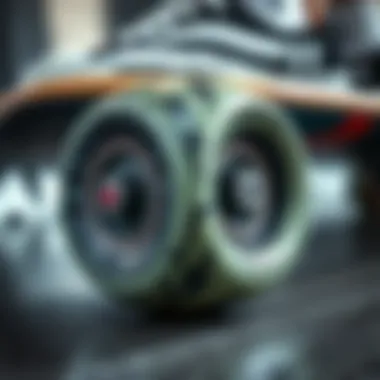

Once the fundamental tricks are locked down, skaters often find themselves eager to explore more advanced techniques. This progression mirrors a natural rhythm; it's about building upon earlier successes and challenging oneself further. Tricks like the 360 flip or noseblunt slide showcase both control and creativity, inviting skaters to express their unique style.
Consider some variables that affect progression:
- Terrain: Practicing on various surfaces can help in adapting body movements for different styles.
- Equipment: A board suited for particular tricks, like a wider deck for stability, can make the learning curve less steep.
- Mindset: Having a resilient attitude plays a significant role. Knowing one's limits yet pushing past them can yield remarkable advancements.
As skills sharpen and confidence grows, the adrenaline rush that comes with nailing a difficult trick becomes a compelling motivation to skate harder.
The Importance of Practice and Consistency
"Skateboarding is a lifelong journey; the more you practice, the smoother the ride." This sentiment resonates deeply within the skate community.
Practice is not just a requirement; it’s a lifestyle. The need for consistency stands as the bedrock of improvement. Successful skaters dedicate themselves to regular sessions, practicing until the movements become second nature. A few points to consider include:
- Routine: Establish a skating schedule. Regular practice can help reinforce new skills and solidify old ones.
- Feedback: Whether you record yourself or skate with friends, external input can prove invaluable for recognizing areas needing improvement.
- Patience: Landing a trick might take dozens, even hundreds of attempts. The journey is as important as the destination, and each failed attempt is a lesson in progress.
Ultimately, the grit and grind of consistent practice contribute greatly to mastering the vast world of skateboarding techniques.
"Whether landing your first ollie or perfecting a complicated trick, the path of a skater is painted with persistence and passion."
The Skateboarding Community
Skateboarding is more than just a sport; it’s a culture that thrives on camaraderie, creativity, and shared experiences. The skateboarding community embodies a unique blend of individuals from various backgrounds, uniting them under the banner of a common passion. This community enriches the sport by fostering connections, promoting inclusivity, and ideating new trends. Understanding the nuances of this community greatly enhances an individual’s skating journey, reflecting on the social fabric that binds skaters together.
Fostering a Supportive Environment
A thriving skateboarding community encourages a supportive atmosphere, which is essential for personal growth and skill development. It’s not about just outdoing one another. Instead, skaters cheer each other on, offering tips, sharing stories, and demonstrating tricks. This positivity makes skateboarding more accessible, particularly for beginners who might feel overwhelmed watching seasoned pros.
Skaters often gather at local parks or makeshift spots, creating a safe space where they can push their limits without fear of judgment. This makes skateboarding appealing to all age groups. Whether you’re a young rider just taking the plunge or someone approaching the sport later in life, the community is there, holding the door wide open.
To bolster this spirit, many local skate shops host meet-ups or skate nights. Here, the vibe isn't about competition; it's about connection. New friendships blossom over a shared love for skating, and this camaraderie often leads to collaborations on new tricks or even mini-videos, showcasing their flair.
“The secret to skateboarding isn't the tricks; it's the people you meet along the way.”
The Role of Skate Parks and Events
Skate parks are the beating heart of the skateboarding community. These spaces not only provide a safe environment for practice but also catalyze social interaction. Parks often serve as venues for competitions, workshops, and demonstrations, helping to bridge the gap between amateurs and pros. In these settings, both emerging talents and veteran skaters can display their skills, inspiring others in ways that videos alone cannot.
Community events, such as competitions or charity skate days, draw people together. They enhance the feeling of belonging; skaters aren’t just individuals on boards; they're often part of a larger movement. Prominent skateboarding events, whether local or national, facilitate networking opportunities, fostering friendships, and career advancements within the skate industry.
Moreover, skate parks contribute to urban landscapes by transforming neglected areas into hubs of creativity and expression. This can be seen in famous skate parks like the Venice Beach Skate Park in California, which attracts skaters from around the globe. Such locations often become synonymous not only with skate culture but also with art, community activism, and the promotion of alternative lifestyles.
Safety in Skateboarding
Skateboarding is about the thrill—a dance on wheels that can often feel like flying. But, before you take off down that incline or attempt a new trick, let’s talk about safety. It’s the cornerstone of any skateboarding venture. No one wants to be taken out of the game by an unnecessary injury. That’s why addressing safety in skateboarding holds paramount importance.
When you strap on a helmet and pads, you're not just putting on gear—you're wrapping yourself in a cocoon of protection. This brings a balance between the exuberance of the sport and the reality of its risks. By focusing on safety measures, not only does one protect their body from falls, but they also enhance their confidence while skating. More confidence means more time spent on the board and less time nursing injuries.
Protective Gear Essentials
Think of protective gear like the armor of a knight but for the streets. The essentials for any skater include:
- Helmets: The most obvious and critical piece of gear. A solid helmet can quite literally save your life. Without it, you’re skating on borrowed time.
- Wrist Guards: Prevents sprains and breaks when you take a tumble. Skaters often instinctively put their hands down to break a fall, which makes these a must-have.
- Knee and Elbow Pads: These pads are vital for cushioning the inevitable bumps and falls, especially when attempting those more complex tricks.
- Shoes: While Converse skate shoes offer exceptional grip and support, make sure they fit snugly to avoid blisters and foot injuries.
It’s also worthwhile to remember that the active choice of wearing protective gear is not only a safety measure—it's also a sign of maturity within the skateboarding community. Respecting each other’s health can go a long way.
Principles of Safe Skateboarding Practices
Engaging in safe practices is just as crucial as wearing the right gear. Think of this as your skateboard etiquette. Here are a few guiding principles to keep in mind:
- Know Your Limits: Skateboarding is as much about skills as it is about self-awareness. Pushing yourself is important but knowing when to hold back can be the difference between a glorious session and a trip to the ER.
- Stay Aware of Your Environment: Whether you're at a skate park packed with people or on quiet street, being aware of your surroundings can help you avoid collisions. Think of it as a dance; you need to know where everyone else moves.
- Practice Falling: This might sound odd, but learning how to fall safely can prevent serious injuries. It’s better to roll when you fall than to try and brace yourself awkwardly.
- Use Designated Areas: Always skate in areas meant for skating. Skate parks exist for a reason. Hazards abound in the streets, and sticking to the parks reduces risks.
- Communicate with Fellow Skaters: If you're skating in groups, a little chatter can go a long way. It keeps everyone informed about what’s happening on the board and potential hazards.
"Safety might seem boring, but one nasty spill can put you off your board for weeks. Invest in safety; it pays dividends in the long run."
By taking safety seriously, skaters can enjoy the thrill of riding while minimizing risks. Holding onto these principles can enhance your skills and empower your skateboarding journey.
Exploring Skateboarding Styles
Skateboarding is not just a sport; it’s a passionate way of life. Understanding the various skateboarding styles is crucial for enthusiasts aiming to deepen their experience. Each style caters to different preferences, techniques, and environments, which makes the exploration of these categories essential for skaters. It’s like getting to know different flavors of ice cream, where each has its unique charm and audience.
Street vs. Vert Skateboarding
Street skateboarding has its roots entwined in urban environments, characterized by the use of everyday objects like benches, stairs, and rails. Skaters devote their energy to performing tricks in public spaces, showcasing creativity in navigating the urban jungle. A prominent feature that defines street skating is its tactical approach to obstacles. It’s not just about the trick; it’s about how creatively one can utilize the surroundings. For example,
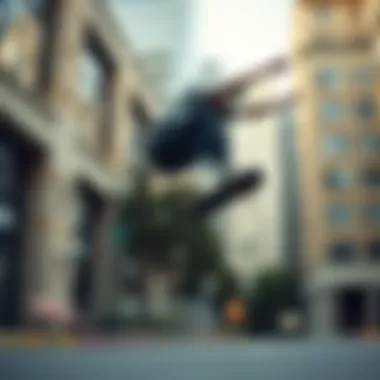
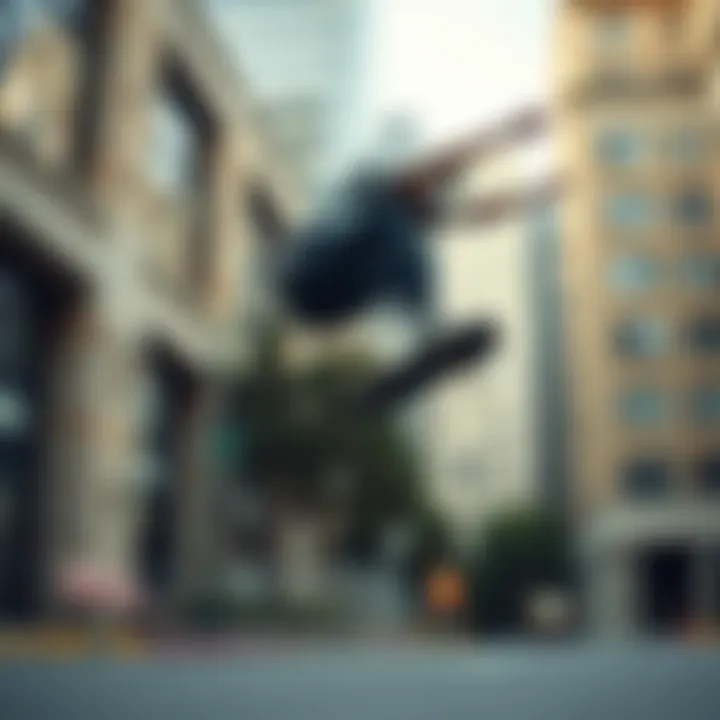
- Kickflips over trash cans
- Grinds on railings
These actions reflect the agility and ingenuity of the street skater.
On the other hand, vert skateboarding is performed on specially designed ramps, offering a different set of challenges and thrills. Skaters launch their boards high into the air, executing gravity-defying tricks that require immense skill and precision. The vert style tends to emphasize height, speed, and aerial maneuvers, with skaters like Tony Hawk pushing the boundaries of what is possible on a half-pipe.
"In street, you’re telling a story with your tricks. On vert, it’s about making the impossible feel like a dream.”
The choice between street and vert can define a skater’s identity. Street skating may seem more accessible to a broader audience, while vert demands specific facilities and a certain level of commitment which not all can afford.
Longboarding: A Different Approach
Longboarding offers a unique twist to the skateboarding spectrum. It’s often seen as a more relaxed cousin to the traditional skateboards, bringing with it a sense of breezy freedom. Longer decks and larger wheels facilitate smoother rides, providing an excellent option for cruising through streets or down hill paths. But don’t let the seemingly laid-back style fool you; longboarding can be challenging in its own right.
Many riders appreciate longboarding’s diverse possibilities; it includes a range of disciplines such as:
- Freeriding: allows skaters to carve smoothly through turns.
- Downhill racing: iconic for its speed and technical skill.
- Freestyle: emphasizing tricks performed while rolling at low speeds.
The culture surrounding longboarding is often more community-oriented, promoting positivity and shared experiences among skaters. Longboarders tend to favor scenic routes, enriching the experience with breathtaking views, making it as much about the journey as the moves.
Cruising vs. Trick Riding
When we dig into skating styles, it’s also important to separate cruising from trick riding. Cruising is about using the skateboard as a tool for commuting or enjoying the ride. You might find someone gliding down their neighborhood streets on a soft, cushy longboard, soaking up the sun. Cruisers typically focus on smooth wheels and a comfortable stance. Some key benefits include:
- Lower risk of injury
- Relaxed environment
- Communal feeling without high stakes
Trick riding, on the other hand, is where the action really heats up. It’s about expressing technical skill through flips, grinds, and combos that demand precision. Whether it’s nailing a nose manual or pulling off a hurricane grind, this style attracts competitive skaters who thrive on adrenaline and challenge. The self-satisfaction attained from a perfectly executed trick is unparalleled.
At the end of the day, the choice between cruising and trick riding can reflect personal values and aspirations within the skate community. Both styles have distinct appeals, enriching the sport with various experiences and narratives that contribute to the cultural tapestry of skateboarding.
Cultural Impact of Skateboarding
The world of skateboarding extends far beyond the confines of skate parks and suburban streets. It has blossomed into a vibrant cultural phenomenon, deeply intertwined with urban landscapes and fashion trends. This section examines the profound implications of skateboarding on society and how Converse, a brand emblematic of the sport, plays an innovative role in shaping this culture.
Skateboarding and Urban Landscapes
Skateboarding has a unique relationship with urban environments. The concrete jungle provides the perfect canvas for skaters seeking to express their creativity. From rails to benches, and even the steps of grand municipal buildings, skaters transform the mundane into extraordinary. Think of it as a dance with the city — each trick and grind showcases the individuality of not only the skater but also the surroundings.
Many cities have embraced this relationship, leading to a resurgence of public spaces designed with skateboarding in mind. Parks such as the Venice Beach Skatepark in California or the MACBA in Barcelona have become sacred sites for aficionados and tourists alike. They weren’t just built for recreation; their design promotes community engagement and urban revitalization. In this sense, skateboarding has moved from being a fringe sport to a legitimate element of urban planning. It educates local governments and citizens alike on the importance of inclusivity and youth culture in public spaces.
"Skateboarding is not just a sport; it's a form of art that reflects the urban reality of our lives."
The presence of skateboarding in urban settings also acts as a catalyst for social change. Skaters often challenge traditional views on how spaces can be utilized. This is particularly relevant in low-income neighborhoods where recreational facilities might be limited. Resourceful skaters innovate by transforming overlooked areas into skateable spots, rallying the community around a common interest and giving a sense of ownership to the space.
Influence of Skate Culture on Fashion
Skate culture has made waves beyond just the skate parks; it's rippled through the fashion industry as well. Converse, with its long-standing connection to the skating world, has been at the forefront of this integration. You'll find that skateboarding has influenced casual wear trends, intertwining elements like baggy pants, graphic tees, and of course, versatile skate shoes into the broader fashion narrative.
Brands have taken notice. No longer merely functional, skate gear now serves as a fashion statement. Companies hype collaborations with influential skateboarders and artists, leading to limited-edition drops that fly off the shelves. However, it's not just about hype; it’s also about identity. Skaters proudly wear their gear as symbols of belonging to a subculture that values creativity, rebellion, and authenticity.
In addition, leading figures in the skate community, who often double as fashion icons, have helped bridge the gap between skateboarding and mainstream media. Creators like Tony Hawk and Nyjah Huston are not just skaters; they are lifestyle influencers shaping what youth view as cool. They’ve seamlessly blended skateboarding with high fashion, streetwear, and even high-end brands, often taking to social media to showcase their unique styles.
The Future of Skateboarding
Skateboarding is not just a sport; it is a lifestyle that continuously evolves. As with any activity, looking ahead is vital in ensuring that the community grows sustainably and effectively. The future of skateboarding encompasses various elements, including trends in equipment, innovations in technology, and shifts in cultural attitudes. Each of these areas plays a crucial role not only in shaping how skateboarders engage with their sport but also in broadening its reach and appeal to new generations.
The importance of understanding future trends is paramount for both seasoned skaters and newcomers. Those who are part of this vibrant community want to stay abreast of advancements that could enhance their experience or influence their style. By paying attention to the nuances that will shape the direction of skateboarding, enthusiasts can make informed choices, whether it's selecting the right gear or understanding the impacts of emerging technologies.
Trends in Skateboarding Gear
When it comes to skateboarding gear, trends often mirror advancements in style, safety, and performance. A notable trend in skateboarding gear is the ongoing push for eco-friendly materials. With sustainability becoming paramount, brands are focusing on minimizing environmental impacts through innovative materials. For example, some skateboard companies are producing boards made from bamboo or recycled plastics, combining durability with an eco-conscious approach.
Here are several significant gear trends to watch:
- Performance Enhancements: Skateboards are increasingly incorporating lighter materials that improve maneuverability without sacrificing strength.
- Protective Gear Innovations: Helmets and pads are not just about safety anymore; they're also about style. Companies are designing these essentials to match aesthetic tastes while offering superior protection.
- Smart Skateboarding Equipment: Some brands are introducing tech-savvy skateboards equipped with sensors. For instance, these boards can track speed, distance, and even performance metrics, making it more engaging for tech enthusiasts.
These trends can not only transform the way individuals engage with skateboarding but also elevate the sport’s visibility. As skateboarders embrace gear that reflects individual styles while addressing environmental concerns, it could usher in a wave of fresh faces eager to join the ranks.
Emerging Technologies in Skateboarding
The horizon of skateboarding looks ever more promising with emerging technologies paving the way for revolutionary changes. From electric skateboards to the integration of advanced robotics, the landscape is rapidly shifting. Innovations allow for an exhilarating experience, whether it is through enhancing performance or enabling entirely new forms of riding.
Electric skateboards stand out among these advancements, providing riders the ability to travel longer distances with minimal effort. These boards typically come equipped with a rechargeable battery and motors that can propel riders to impressive speeds. This shift can change how urban areas view skateboarding as a viable mode of transportation.
Another fascinating technology is the introduction of virtual and augmented reality in skateboarding. Training applications now allow newcomers to experience skateboarding in virtual landscapes, learning moves before attempting them in the real world. This can lead to fewer injuries and foster confidence in beginners as they progress.
As skateboard technology continues to advance, it is bound to ignite fresh discussions about sustainability, community engagement, and inclusivity.
The synergy between technology and skateboarding could redefine how we practice, connect, and experience the thrill of the ride.
On this promising note, it’s clear that the future of skateboarding is brighter than ever, inviting not only seasoned riders but also curious newcomers to explore its depths. The journey ahead will undoubtedly require adaptability and openness; yet, with each bounce of the skateboard wheels, the culture only becomes richer.







